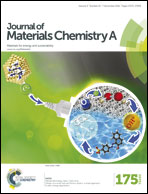Electrostatic assembly of composite supercapacitor electrodes, triggered by charged dispersants†
Abstract
This article reports the fabrication of MnO2–multiwalled carbon nanotube (MWCNT) electrodes for supercapacitors with high areal capacitances, low resistance and good capacitance retention at high charge–discharge rates, achieved at high active mass loadings. The key to achieving enhanced electrochemical performance was a good mixing of well dispersed MnO2 and MWCNT by an electrostatic assembly in the non-aqueous media. The approach is based on the use of anionic dispersants for MnO2 and cationic dispersants for MWCNT with selective adsorption. Strong adsorption of the dispersants on the particle surface was a prerequisite for efficient dispersion. The analysis of different adsorption mechanisms highlighted the importance of the use of chelating molecules, which allow for strong polydentate bonding. Testing results provided an insight into the influence of the functional groups and size of the dispersant molecules on the electrode performance. The highest capacitance of 2.39 F cm−2 at a scan rate of 100 mV s−1 has been achieved for MnO2–MWCNT electrodes. The electrostatic assembly strategy has opened a path for the fabrication of efficient supercapacitor devices, which showed promising performance for practical applications.


 Please wait while we load your content...
Please wait while we load your content...